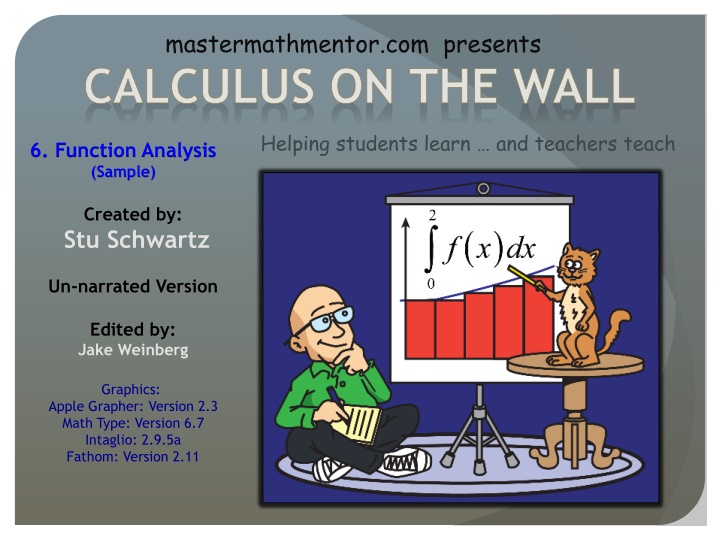
Understanding Function Analysis in Calculus
Enhance your understanding of function analysis in calculus with this sample lesson. Learn about critical points, relative extrema, concavity, and more. Explore how to determine intervals of concavity, find inflection points, and sketch possible functions based on given information.
Download Presentation

Please find below an Image/Link to download the presentation.
The content on the website is provided AS IS for your information and personal use only. It may not be sold, licensed, or shared on other websites without obtaining consent from the author. If you encounter any issues during the download, it is possible that the publisher has removed the file from their server.
You are allowed to download the files provided on this website for personal or commercial use, subject to the condition that they are used lawfully. All files are the property of their respective owners.
The content on the website is provided AS IS for your information and personal use only. It may not be sold, licensed, or shared on other websites without obtaining consent from the author.
E N D
Presentation Transcript
mastermathmentor.com presents CALCULUS ON THE WALL Helping students learn and teachers teach 6. Function Analysis (Sample) Created by: Stu Schwartz Un-narrated Version Edited by: Jake Weinberg Graphics: Apple Grapher: Version 2.3 Math Type: Version 6.7 Intaglio: 2.9.5a Fathom: Version 2.11
Relative Extrema Critical Points are defined as x-values where f (x) = 0 or f (x) does not exist. If f (x) changes from negative to positive at c, then there is a relative (local) minimum at x = c, and f(c) is a relative minimum of f. If f (x) changes from positive to negative at c, then there is a relative (local) maximum at x = c, and f(c) is a relative maximum of f. c c f has a relative minimum at x = c f has a relative maximum at x = c Finding relative extrema by the signs of f (x) is called the first derivative test. www.mastermathmentor.com
Example Find the intervals in which the function is concave up and concave down, any inflection points, and graph the function. a. f(x) = 1 + 6x2 2x3 x ( )=12x-6x2= 0 6x 2- x ( f x ( ) has critical points at x = 0,x = 2 sign f chart 0 2 f )= 0 x ( ):----0+++++0----- f is increasing on (0, 2) f is decreasing on (- ,0) and (2, ) There is a relative minimum at (0, 1) There is a relative maximum at (2, 9) x ( ) =12-12x = 0 ) = 0 x ( ) has critical points at x =1 x ( ):++++++------- f 12 1- x ( f sign f chart 1 f is concave up on (- , 1) and concave down on (1, ). There is an inflection pt. at x = 1. www.mastermathmentor.com
Going Backwards Typically, given a function you can find its first and second derivatives. But, if we are given a graph of f (x), the derivative of a function f(x), we can sketch a graph of a possible function fitting that information. Given f (x), sketch a possible f(x) Since f (x) is the slope of the given f (x), and the slope is positive, we make a sign chart of f (x): x ( ):+++++++++++++ f is concave up on - , f ( ) Since we have f (x), we find that there is a critical point at x = 1. x ( ):------0++++++ 1 f is decreasing on - ,1 ( f has a relative minimum at x =1 f ) and increasing on 1, ( ) Any of these graphs fit the criteria. www.mastermathmentor.com
Function Analysis & Related Rates Functions can represent changing information over time f(t) and thus its derivative f (t) and 2nd derivative f (t) have meanings in context. p t ( )= 0: 4,5 ( ) 1. Price is steady. Let p(t) represents the price of gasoline on day t of a specific week. This graph is y = p (t). Determine the time or interval of time: p t ( )>0: 0,4 ( ) 2. Price is increasing. 3. Rate of change of price is positive and constant. p t ( )= +C: 2,3 ( ) 4. Rate of change of price is increasing. p ( ) t ( )= 0,2 ( p t ( )> 0: ) ), 6,7 ( p t ( ) switches from positive to negative: 4,5 5. Price is at a maximum. ( ) p t ( ) has its smallest value: day 6 6. Change of price is at a minimum. www.mastermathmentor.com
Purchase the full version - 29 slides Content: Function Analysis www.mastermathmentor.com Powerpoint slides to help teach in the classroom Only $10.95 for the full presentation of 29 content slides. (download version) You receive: A narrated version (84 megs) An un-narrated version (9 megs) A PDF of the narration used if you want to provide the commentary Note: Downloading the full presentation may require high-speed internet. Or purchase the entire set of MasterMathMentor.com AB Calculus On the Wall Powerpoint presentations - Only $119.95 - sent to you on a 2-gig flash drive. Topics cover: Limits Derivative Definition Motion Related Rates Optimization Antiderivatives Definite Integrals Area/Motion Revisited Inverses/Transcendentals Differentiation Function Analysis Riemann Sums Volume Differential Equations www.mastermathmentor.com
